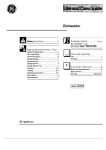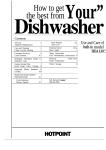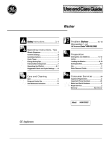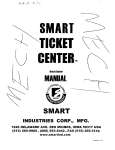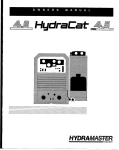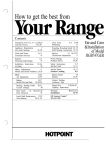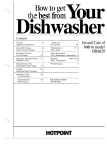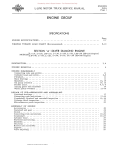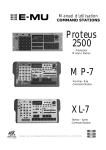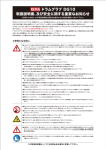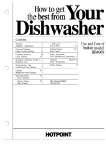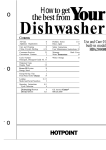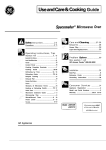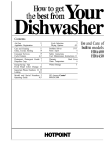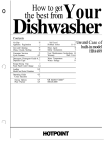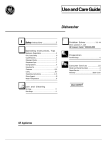Download Hotpoint HDA6009 User's Manual
Transcript
o
‘owtogetYour
Dkhwmher
the best from
Contents
Air Gap
Appliance Registration
12
2
Soil Level
Problem Solver
Care and Cleaning
China, Crystal, Sterling
12
11
Rinse Agent
Safety Instructions
Consumer Services
Cycle Features
19
4,5
Detergent, Detergent Guide 6, 7
Dispenser Cups
7
9
7
Water Temperature
Winter Storage
8-10
2
Operating Guide
Cycle Selection
4,5
5
Drying Options
Plate Warmer
4,5
4,5
6
3
User Maintenance Instructions 12
Back Cover
Warranty
Energy-Saving Tips
2
Front Panel Color Change 13
Loading
Model and Serial Numbers
7
14-16
GE Answer Center(”)
800.626.2000
6
12
Use and Care of
btit-h model
mA600:
HELP US HELP YOU...
Before using your
dishwasher, read
this guide carefully.
It is intended to help you
operate and maintain your
new dishwasher properly.
Keep it handy for answers to
your questions.
If you don’t understand something
or need more help, write (include
your phone number):
Consumer Affairs
Hotpoint
Appliance Park
Louisville, KY 40225
If you received
a damaged dishwasher...
Write down the model
and serial numbers.
Immediately contact the dealer
(or builder) that sold you the
dishwasher.
You’ll find them on a label
fastened to the tub wall just
inside the dishwasher door.
These numbers are also on the
Consumer Product Ownership
Registration Card that came
with your dishwasher. Before
sending in this card, please
write these numbers here:
Save time and money.
Before you request
service . . .
Check the Problem Solver in the
back of this guide. It lists causes
of minor operating problems that
you can correct yourself.
Model Number
Serial Number
Use these numbers in any
correspondence or service
calls concerning your dishwasher.
~ YOU NEED SERVICE...
To obtain service, see the Consumer
Services page in the back of this guide.
We’re proud of our service and want you to be
pleased. If for some reason you are not happy with
the service you receive, here are three steps to follow
for further help.
FIRST, contact the people who serviced your
appliance. Explain why you are not pleased. In
most cases, this will solve the problem.
NEXT, if you are still not pleased, write all
the details—including your phone number—to:
Manager, Consumer Relations
Hotpoint
Appliance Park
Louisville, KY 40225
FINALLY, if your problem is still not resolved, write:
Major Appliance Consumer Action Panel
20 North Wacker Drive
Chicago, IL 60606
ENERGY-SAVING TmS
●
Operate dishwasher only when it’s full. Let the
dishes accumulate in dishwasher. When you put in
only a partial load, use the RINSE & HOLD cycle to
rinse off heavy soils. Be sure to latch the door when
waiting for a full load. This helps keep soils moist,
easier to remove.
2
If you don’t need your dishes right away, use
your ENERGY SAVER option (energy saver
drying feature) that turns the drying heater off
automatically. Dishes dry naturally over a longer
period such as overnight.
● Always select the cycle that uses the least amount
of water that will remove the soil from the load.
(See the Operating section).
●
A
●
WARNING-When using this
appliance, always exercise basic
safety precautions, including the
following:
Use this appliance only for ik intended
purpose, as you till find described in this
Use and Care Guide.
a
●
Use only powder or liquid detergents or wetting
agents recommended for use in a dishwasher.
Do not wash plastic items unless marked
“dishwasher safe” or the equivalent. For plastic
items not so marked, check the manufacturer’s
recommendations.
Load light plastic items so they will not
become dislodged and drop to the bottom of
the dishwasher—they might come into contact
with the Calrod” heating element and be damaged.
To minimize the possibility of inju~.
●
●
●
●
s Do not store or use combustible
materials, gasotine or other
1. . . . flammable vapors and liquids
%
in the vicinity of this or any other appliance.
●
●
●
This dishwasher must be properly
installed and located in accordance
‘a-,”:’ ~
y
+
.-.
with the Installation Instructions
. . ...
before it is used. If you did not
receive an Installation Instructions sheet with your
dishwasher, you can obtain one by calling, toll
free, the GE Answer Center”, 800.626.2000.
—This appliance must be connected to a
grounded metal, permanent wiring system; or
an equipment-grounding conductor must be
run with the circuit conductors and connected
to the equipment-grounding terminal or lead
of the appliance.
—Connect to a properly rated, protected and sized
power-supply circuit to avoid electrical overload.
●
●
When loading items to be washed:
A. Locate sharp items so that they are not
likely to damage the door seal, and
B, Load sharp knives with the handles up
to reduce the risk of cut-type injuries.
Do not tamper with controls.
●
Do not touch the Cdrod” heating element dufing
or immediately after use.
Do not operate your dishwasher unless all
enclosure panels are properly in place.
Do not abuse, sit on, or stand on the door
or dish rack of the dishwasher.
Close supervision is necessary if this appliance
is used by or near children. Do not allow children
to play inside, on or with this appliance or any
discarded appliance. Dispose of discarded
appliances and shipping or packing material
properly. Before discarding a dishwasher, remove
the door of the washing compartment.
Keep all washing detergents and wetting agents
out of the reach of children, preferably in a locked
cabinet. Observe all warnings on container labels
to avoid personal injury.
To minimize the possibility of
/“
electric shock, disconnect this
/“
appliance from the power supply
before attempting any maintenance. NOTE:
Turning the control dial to the OFF position
does not disconnect the appliance from the
power supply. We recommend having a qualified
technician service your appliance.
P
●
●
A
WARNING-HYDROGEN GAS
is produced by the chemical action
within your water heater, It can
accumulate in the water heater andor
water pipes if hot water has not been used for a
period of two weeks or longer. HYDROGEN GAS
IS EXPLOSIVE. To prevent the possibility of
damage or injury, if you have not used hot water
for two weeks or more, or moved into a residence
in which the hot water system may not have been
used for some time, turn on all hot water faucets
and allow them to run for several minutes before
using any electrical appliance which is connected
to the hot water system. This will allow any
hydrogen gas to escape. Also, since the gas is
flammable, do not smoke or use an open flame
or appliance during this process.
SAVE THESE
INSTRUCTIONS
3
HOW TO OPERATE YOUR DISHWASHER
STEP 1. Load your dishwasher with dishes, silverware,
pots, pans, bowls, etc., according to the Loading section.
STEP 2. Add detergent to the detergent dispenser.
Make sure the Cycle Indicator Dial is at OFF position
before adding detergent. (See Detergent Guide).
Use rinse aid agent to help prevent spotting. Occasionally
check to insure that rinse agent container is at least half
full. (See How to Use a Rinse Agent section).
STEP 3. Select drying option.
I
H;\T;D ENERGY
SAVER
HEATED DRY. Turns the
drying heater on for fast drying.
m
ENERGY SAVER. Turns the drying
M
heater off to save energy. The dishes
will dry naturally over a longer period such as overnight.
If you need your dishes sooner, open the dishwasher
door after the cycle is complete to reduce the natural
drying time.
Use of this option reduces the electrical energy used
by this model approximately 10% for the NORMAL
WASH cycle.
STEP 4. WATER HEAT energy option.
The wash cycle will be extended for 9 minutes while
the dishwasher heats the water for good washing
and drying. The entering water must be at least
120°F. See How to Test the Water Temperature section.
STEP 5. Select the wash cycle and start the dishwasher.
(See Cycle Selection Hints).
If your dishwasher drains into a food waste disposer,
operate the disposer until it is empty before starting
the dishwasher.
To obtain the benefits of a complete cycle,
be careful that you do not turn the dial any
farther than necessary to start the dishwasher.
4
For POTS & PANS, NORMAL WASH
and WATER SAVER cycles:
a. Push selected cycle button.
●
bLatchthedo(’r
m
c. Slowly turn the Cycle
.,.1. ,.1,.1.,
I
Indic;tor Dial to ON
position to start the
washing
cycle. You will hear
ON .
the motor start. There
OFF
(*
)
RINSE ,,,
is a time delay between
& HOLD
the start-up and the water
d~lng e
. P1ATEW4RMER ff,,
fill so you will not hear
any wash action right away.
For RINSE & HOLD cycle:
a. Be sure door is unlatched.
b. Select ENERGY SAVER
drying option.
c. Slowly turn the Cycle
[ndicator Dial to the
RINSE & HOLD position.
d. Latch the door to start the cycle.
For PI. ATE WARMER cycle:
a. Load clean plates and dishes
washin.
to be warmed.
b. Select HEATED DRY
drying option.
c. Leave the door unlatched.
d. Slowly turn the Cycle
Indicator Dial clockwise
to the PLATE WARMER position.
e. Latch the door to start the cycle.
●
●
●
●
Cycle Selection Hints
It is important to follow the Loading instructions.
●
●
POTS & PANS—For items such as pots, pans
cookware, dishes and glasses with heavy soil.
Everyday dishes may be included.
NORMAL WASH—For loads of everyday dishes,
glasses and cookware with medium soils. Designed
to yield high performance on normal soils.
●
●
●
WATER SAVER—For dishes with light soils that
have not dried on, or that have extra preparation
before loading. It saves water and energy.
RINSE & HOLD—For rinsing partial loads which
will be washed later. D{) not u.~e detergent.
PLATE WARMER—For warming clean dishes
and serving plates for the serving of hot food.
What Happens in Each Cycle
During the drying period:
—The motor stops.
— Water vapor comes through the vent by the
door latch during drying and when water is
being pumped out.
You’ II hear occasional c1 icking sounds:
—Soft food disposer shredding action.
—Drain valve opening to pump water out.
—Timer control as cycle progresses.
—Detergent cup opening.
●
●
Gallons
(:ipprox,)
Wosh cycle
Time
Minutes
(Llppl”ox.)
I 1.4
95:1:
NORMAL WASH
1 I.4
~~:1:
WATER SAVER
~,~
~fi:,:
RINSk; & HOLD
3. I
10
W:l[el” use
Wash (:ycles
POTS &
PANS
Cycle Sequence
mmmmmmm
Bmmmmmm
mmmmm
mm
‘}: Unextended times. These cycle times will be incrc:iscd
appr(]ximately 9 minutes if Water Hc~I[ energy option” is selected.
Drying Options:
HEATED DRY. Avtiilable on till wash cycles cxccpt RINSE & HOLD. Add 29 minutes to wush cycle time.
ENERGY SAVER. Drying heater is turned off’. Dishes dry nuturally.
Good dishwashing starts with HOT water
To get dishes clean and dry you need hot water. To help you get water of the proper temperature,
your dishwasher has a WATER HEAT feature that automatically senses the temperature of the water
in the wash cycle and heats it, if necessary, to the proper temperature. This water heating feature may allow
you to turn down your household water heater and save energy if you’re willing to let the dishwasher run a little
longer while it heats water to the proper temperature. For good washing and drying, the entering water must be at
least 120°F. To prevent dish damage, inlet water should not exceed 150°F.
5
How to Test Water Temperature
Higher water temperature is needed to dissolve grease
and octivate powder detergents. Check water temperature
with a candy or meat thermometer. Turn on the hot water
faucet nearest dishwasher. Put the thermometer in a glass
and let the water run continuously into the glass until the
temperature stops rising. If the water temperature is
below 120°F., adjust your water heater.
Helpful hints: lfoutside temperatures are unusually low,
or if your water travels a long distance from water heater
to dishwasher, you may need to set your water heater’s
thermostat up. If you have not used hot water for some
time, the water in the pipes will be cold. Turn on the hot
water faucet at sink and allow it to run until water is hot.
Then start dishwasher. If you’ve recently done laundry or
run hot water for showers, give your water heater time to
recover before operating the dishwasher.
To improve washability if water is less than 120°F.
and you cannot adjust your water heater: Select a
longer cycle and fill both detergent cups at least
half-full with detergent.
How to Use a Rinse Agent
The rinse agent makes water flow off dishes quicker
than usual. This lessens water spotting and makes
drying faster, too.
For best dishwashing performance, use of a rinse
agent such as JET-DRY brand is recommended.
Rinse agents come in either liquid or solid form.
Your dishwasher uses the liquid form.
~til\\ –~,II!IV I,m
How to fill rinse agent dispenser.
Unscrew the cap. Add liquid rinse agent Y
,! ~•Ü‹
until it just reaches the bottom of the lip
d’
inside the dispenser opening. Replace the
Y
cap. The dispenser automatically releases
FULL
the rinse agent into the final rinse water.
If you accidentally spill: Wipe up the rinse
agent with a damp cloth. Don’t leave the spill in the
dishwasher. It can keep your detergent from working.
If you can’t find any rinse agent, write:
BENCKISER CONSUMER PRODUCTS, INC.
(“JET-DRY”)
Corporate Centre 1
55 Federal Road
P. O. Box 1991
Danbury, CT 06813-1991
How to Choose and Use the Right Detergent
First, use only powder or liquid detergent
specifically made for use in dishwashers.
Other types will cause oversudsing.
Second, check the phosphate content. Phosphate
helps prevent hard-water materials from forming
spots or film on your dishes. If your water is hard
(7 grains or more), your detergent has to work
harder. Detergents with a higher phosphate level
will probably work better. If the phosphate content is
low (8.7% or less), you’ll have to use extra detergent
with hard water.
Your water department can tell you how hard your
water is. So can your county extension agent or your
area’s water softener company. Just call and ask them
how many “grains” of hardness there are in your water.
6
How much detergent should you use? That
depends. Is your water “hard” or “soft”? With
hard water, you need extra detergent to get dishes
clean. With soft water, you need less detergent.
Too much detergent with soft water not ,only wastes
money, it can be harmful. It can cause a permanent
cloudiness of glassware, called “etchin&.” An outside
layer of glass is etched away! Of course this takes
some time. But why take a chance when it’s easy
to find out the hardness of your water.
Keep your detergent fresh and dry. Under the sink
isn’t a good place to store detergent because there is too
much moisture. Don’t put powder detergent into the
dispenser until you’re ready to wash dishes. (It won’t be
fresh OR dry).
If your powder detergent gets old or lumpy, throw it
away. Old detergent often won’t dissolve. If you use a
liquid dishwasher detergent, these precautions are not
necessary because liquid detergents don’t “lump’. as
they age or come in contact with moisture.
You’ll find two detergent dispensers on the inside
door of your dishwasher. Two, because some cycles
use two washes.
CUP
Close the main cup
reduce the amount of detergent
and rin.~e aid agent .~pillage into the tub.
‘
CLOSE TIGHTLY
Detergent Usage Guide (powder or liquid)
SOFT WATER
(0-3 grains hardness)
MEDIUM WATER
(3-7 grains)
HARD WATER
(7- 12 grains*)
CYCLES
Main Cup
Main Cup
Main Cup$
POTS & PANS
NORMAL WASH
Half Full
WATER SAVER
Half Full
Open Cup
Completely + Half Full
Full
I
Half Full
None
+ Half Full
I
RINSE & HOLD
I
None
Use no detergent
Open Cup
I
Use no detergent
*12 grains and up is extremely hard water, A water softener is recommended. Without it,
lime can build up in the water vtilve. The water valve may stick while open and cause tlooding.
Open Cup$
Completely + Completely
Full
Full
I
None
Completely
Full
I
Use no detergent
:\: Filled Main Cup holds 3 tablespoons;
Filled Open CLIp holds 2 tablespoons.
How to Prepare the Dishes for Washing
If this is your first dishwasher, or if you’re replacing
a much older model, you may wonder how much
preparation your dishes need. Actually very little.
Prerinsing of normal food soils is not necessary.
With common sense and a little practice you’ll soon
know what foods to remove. Here are some guidelines:
1. Scrape off bones, seeds, skins, toothpicks and other
hard solids. It is also best to remove hard-shelled
vegetables, meat trimmings, leafy vegetables and
crusts. Remove excessive quantities of oil or grease.
2. Remove large quantities of any food. Your
dishwasher has a built-in soft food disposer that
pulverizes soft food bits and tlushes them away.
It can handle small amounts of soft foods, but
large amounts will be difficult to handle.
3. Try to remove food scraps and place dishes in
dishwasher before soil has a chance to dry and
become hard. Dishes with dried-on soil are more
difficult to wash and may not come clean in the
POTS & PANS cycle. Remember to use your
RINSE & HOLD cycle for small “holding” loads.
NOTE: The foods mentioned are examples only.
Other foods not mentioned may also need to be
removed from your dishes. You may also want to
consider removing foods such as mustard, mayonnaise,
vinegar, lemon juice and other foods that can cause
discoloration of stainless steel if allowed to remain
on dishes for a long period of time.
When using the POTS & PANS cycle, less preparation
is required before loading. The POTS & PANS cycle can
wash heavily soiled dishes and remove dried-on and
baked-on soils from pots, pans and casseroles. Items with
burned-on soils may not come clean, and the dishwasher
cannot remove burn marks or restore fading caused by
overheating during cooking.
7
HOW TO LOAD YOUR DISHWASHER
This is (1 r(~ndorn mixed loud, the most common type
you will have.
Make sure dishes are properly loaded to insure that
water can reach the soiled surfaces. The wash arm
in the bottom sprays water up. The tower that rises
in the center sends water out over the dishes to wash
the items in the upper rack. A spray arm in the top
washes down also. Make sure to place tall items to
the outside so the upper wash arm is not blocked.
WATCH OUT FOR THIS.
The wash tower rises through the center of the bottom
rack during the wash and rinse portions of the cycle.
Don’t block it or load tall things next to it. Also, be
careful not to let a portion of an item such as a pot or
dish handle extend through the bottom rack. This could
block the wash arm and cause poor washing results.
HOW TO LOAD THE TOP RACK
Sauce pans, mixing bowls and other small items may
be placed—face down—in the top rack. The top rack
is handy for all kinds of odd shapes. Be sure the force
of the water and detergent can reach soiled surfaces.
8
The to~ rack is best for ~lasses. CUDS and saucers.
Cups ;nd glasses fit bes;along”the’sides, This is the
place for dishwasher-safe plastics, too. Make sure
small plastic items are lodged in tightly so they can’t
fall onto the Calrod@ heating element. Arrange
stemware so that they cannot move easily. Don’t
let the glasses touch each other.
—
Shelf Up
Fold the folding shelf up for glasses and tall things.
Place tall items to the outside so the upper wash arm
is not blocked.
Shelf Down
The folding shelf gives you extra space for cups and long
utensils on two levels. Loud the lower level first, then fold
the shelf down.
HOW TO LOAD T‘HE BOTTOM WCK
Fit plates and saucers between the pins. Load platters,
pots and bowls along the sides, in corners or in the back.
As shown here this plate is being placed with the soiled
side facing the center of the rtick so water and detergent
from wash arm can reach soiled surfaces.
((’1)11/;llltC,C/ llC’.\’f /J[l,?f,)
9
HOW TO LOAD Tm BOTTOM WCK
(continued)
1
Pots, pans, casseroles, salad bowls, mixing bowls and
lids l~zu,st be loaded in the bottom rack, facing down.
Heavily soiled pots, pans and casseroles must be
loaded in the bottom rack, facing down. Prop broiler
pans and racks along the edge. Shallow items may be
angled provided the lower side does not shield the
soiled surface inside from the water.
Precaution!
Take out anything that may fall or extend through the
bottom of the basket.
Put flatware in the removable basket with handles
up to protect your hands. Mix knives, forks and
spoons so they don’t nest together. Distribute evenly.
Small plastic items, such as measuring spoons and
lids from small containers, are not recommended for
automatic dishwashing. If placed in the dishwasher,
they should go in the bottom of silverware basket
with silverware on top.
10
WHAT YOU CAN USUALLY WASH SAFELY
IN YOUR DISHWASHER.
k
Subhead that goes all the way across
Material
Usually
Safe
Exceptions (not safe)
Special Instructions
Aluminum
YES
Some colored anodized
aluminum can fade.
Some darkening or spotting possible. Remove by
scouring with soap-filled steel wool pads.
Chinti
Stoneware
YES
Antique, metal-trimmed,
hand-painted or over-the-glaze
patterns fade. Gold leaf
will discolor.
[fin doubt, check with the manufacturer. Or test wash
one piece daily for at least a month. Compare with the
rest of the set.
Crystal
YES
Antique, metal-trimmed or
hand-painted patterns fade.
Gold leaf will discolor.
Load securely to prevent movement. Check your
manufacturer’s instructions for your crystal.
Non-dishwasher
items—such
as electronic
air cleaner
filters, furnace
filters, paint
brushes, etc.
NO
Glass
YES
Milk glass may yellow.
Iron
NO
Iron will rust.
Pewter tarnishes.
Do not wash in dishwasher. Damage to dishwasher
and discoloration or staining of dishwasher may result.
Pewter
NO
Plastics
YES
If it doesn’t say DISHWASHER SAFE, test one piece in
the top rack before dishwashing an entire set.
Stainless steel
YES
Rinse if not washing immediately. Salty or acid foods
can stain if left on.
Sterling Silver
and Silver plate
YES
Non-stick
coatings
YES
Don’t put in same silverware
basket with stainless steel.
Contact between metals can
damage silver.
Don’t wash copper utensils in
the same load. Silver may get a
brown film.
Adhesive used to attach some
hollow-handle knives can loosen.
Rinse if not washing immediately. Salty or acid foods can
stain if left on. Dry detergent can cause difficult-to-remove
black spots. Place in back section of silverware basket to avoid
exposure to detergent from the detergent cup.
After washing, wipe the non-stick coating area with
vegetable oil to keep it from losing its non-stick quality.
Tin
NO
Tin can rust.
W()()d
NO
Wood can warp, crack or lose
its finish with any type of washing.
Forget a dish? Here’s when you can add it.
Add dishes any time during the RINSE & HOLD
cycle. With other wash cycles, you can add dishes
at any time BEFORE the main detergent wash portion
of the cycle.
However, opening the door during any cycle
lessens cleaning power. So try to load everything
at the beginning.
Here’s how to add a forgotten dish:
1. Push the door latch to the left. Washing will stop
2. Wait a few seconds until the water calms. Then
open the door. WARNING: Hot vapor may rise
from opened door.
3. Add dishes you’ ve forgotten.
4. Close the door and push the latch to the far right.
When the door is locked, washing will continue.
11
CAm Am CLEANING
USER MAINTENANCE INSTRUCTIONS
Clean the control panel with a lightly dampened
cloth. Dry thoroughly. Do not use abrasives or
sharp objects on the panel. They can damage it.
Clean the outside with a good appliance polish
wax. The outside cabinet finish is durable, but it
can scratch. So use no scouring pads, or harsh or
gritty cleaners.
Appliance Polish Wax & Cleaner (Cat. No.
WR97X02 16) is available from GE Appliance
Parts Marts.
The inside usually takes care of itself. If it should
ever need cleaning, use a mild cleansing powder.
Scouring pads and harsh cleaners can mar the finish.
Not Using Your Dishwasher in Winter? Protect Against Freezing.
If your dishwasher is left in an
unheated place during the winter,
ask a service technician to:
Cut off electrical power to the
dishwasher. Remove fuses or trip
circuit breaker.
Turn off the water supply.
Disconnect the water inlet line
from the water valve.
●
●
●
●
●
●
●
Drain water from the inlet line and
water valve. (Use a pan to catch
the water).
Reconnect the water inlet 1 ine to
the water valve.
Drain the collection chamber at
rear of unit below filter by
disconnecting hose to pump.
Reconnect after draining.
Remove the plastic pump cover
in the tub bottom and use a sponge
to soak up water in the rubber boot.
PUMP COVER SCREWS
..:.:.:.:.:.*::::::::::....
-
/
p:*i-
Built-in Dishwashers Often Use an Air Gap. Keep It Clean.
An air gap is a plumbing device. It
protects your dishwasher against
water backing up in it it if a drain
clogs. The air gap is not a part of
the dishwasher. And you may not
even have one. Not all plumbing
codes require air gaps.
Check the air gap any time your
dishwasher isn’t draining well. If
you have an air gap, check it at
least once a month. IT IS NOT
PART OF YOUR DISHWASHER.
IT IS NOT COVERED IN YOUR
WARRANTY.
12
The air gap is easy to clean.
With most types, first turn off the
dishwasher, then lift off the chrome
cover. Then unscrew the plastic cap
and check for any buildup of grit.
A toothpick makes cleaning easy.
If you are redecorating, you can change your
dishwasher’s front panels to match or blend
with your new colors.
The panels are held in
place by the door trim
and the trim on the
panel below the door.
Each side of each
panel is a different
color. Or you can
paint a panel with
the color of your
own choice.
NOTE: Do not operate the dishwasher while
changing panels or when lower access panel is
removed.
How to change the door panel:
1. Take out trim screws on either side of the
dishwasher door. Remove the side trim.
2. Slide the door panel out.
(Careful—edges may be sharp.)
3. Turn the door panel around and put the color you
want in front.
4. Replace the door panel, side trim and screws.
How to change the lower panel:
1. Remove panel attachment screws.
2. Remove the entire panel.
3. Take out screws and remove the top trim.
4. Slide the door panel out.
5. Turn the panel around and put the color you want
in front.
6. Replace the lower panel, top trim and screws.
7. Replace the entire panel and attachment screws.
Wood panel trim kit GPF 40 contains trim and
instructions for adding a decorative wood door panel
and lower access panel no thicker than 1/4” to match
kitchen cabinets.
Use the order form in the back of this guide to order,
without charge, a color panel not supplied with your
dishwasher or a wood panel trim kit GPF40.
13
QUESTIONS?
USE THIS PROBLEM SOLVER
PROBLEM
POSSIBLE CAUSE
DISHWASHER
WON’T RUN
A fuse in your home maybe blown, or the circuit breaker tripped. Replace fuse or
reset circuit breaker. Remove any other appliances from the circuit.
UNUSUAL NOISE
Utensils may not be secure on rack pins, or something small may have dropped from
the rack. Water is causing utensils to rattle. Make sure everything is securely placed
in dishwasher.
DISHES DON’T DRY
Make sure inlet water temperature is correct. (See How to Test Water Temperature
section).
Unload the bottom rack first. Water from dishes in the top rack may be spilling into
the bottom rack.
Check for improper loading. Dishes shouldn’t nest together. Avoid overloading.
Check the rinse agent dispenser to see that it’s not empty.
UNCLEAN DISHES
AND FLATWARE
Check inlet water temperature. It should be at least 120°F. (To test, see How to Test
Water Temperature section).
Water pressure may be temporarily low. Turn on a faucet. Is water coming out slower
than usual? If so, wait until pressure is normal before using your dishwasher.
Plugged air gap. (See Care and Cleaning section).
Improper rack loading. (See Loading section).
DETERGENT LEFT
IN DISPENSER CUPS
Water may not be reaching the detergent cups. Move dishes that may be blocking
detergent cup.
The dispenser cover may not be opening or may be blocked by improperly loaded
items. If you used a powder detergent, open the cup and remove any caked-on
detergent. If the cup still doesn’t open automatically, call for service.
Detergent may be old. If the powder detergent is hard or caked in the box, throw it
away. The detergent may not be working well. Try another brand.
DETERGENT CUP
LID WON’T LATCH
AFTER ADDING
DETERGENT
Cycle Indicator Dial must be OFF for cup lid to close and latch properly. [f you
unlatch the door and open it to dry your dishes, the Cycle Indicator Dial does
not advance by itself.
YELLOW OR
BROWN FILM
Tea or coffee can stain cups. Remove the stain by hand, using a solution of 1/2 cup
bleach and 3 cups warm water.
An overall yellow or brown film on dishes or glassware can be caused by iron
deposits in water. A special filter in the water supply line is the only way to correct
this problem. Your water softener company can tell you about the filter.
Yellow film on sterling silver results when you wash copper utensils in the same load.
Silver polish will usually remove this stain.
14
PROBLEM
POSSIBLE CAUSE
SPOTS AND
FILMING ON
GLASSES AND
FLATWARE
Spotting can be caused by all these things:
c Extremely hard water. (See How to Choose and Use Detergent section).
●
Low inlet water temperature. (See How to Test Water Temperature section).
●
Overloading the dishwasher.
●
Improper loading. (See Loading section).
. Old or damp powder detergent.
●
Phosphate level in detergent too low. (See How to Choose and Use
Detergent section).
Rinse agent dispenser empty. (See How to Use a Rinse Agent section).
●
Too little detergent. (See How to Choose and Use Detergent section).
●
Local water conditions and personal preferences vary. Try several brands of
detergents to find one that gives the best results for you. A liquid dishwasher
detergent may help reduce filming.
To remove stubborn spots and film from glassware:
1. Remove all metal utensils from the dishwasher.
2. Do not add detergent.
3. Select POTS & PANS cycle.
4. Start the dishwasher and allow to run for 18 to 22 minutes. The dishwasher will
now be in the main wash.
5. Then open the door and pour 2 cups (500 ml) of white vinegar into the bottom of
the dishwasher.
6. Close the door and allow to complete the cycle.
If vinegar rinse doesn’t work: Repeat as above, except use 1/4 cup (60 ml) of citric
acid crystals instead of vinegar. (Most drugstores carry citric acid crystals. If yours
doesn’t, call GE Factory Service).
Using a vinegar or citric acid crystal rinse more than twice a month? Consider a home
water softener.
CLOUDINESS ON
GLASSWARE
If vinegar or citric acid crystal rinse doesn’t work, the cloudiness is “etching.”
The film cannot be removed.
It can be prevented: Use less detergent if you have soft water. Wash glassware in
the shortest cycle that will get them clean.
Water temperature entering dishwasher exceeds 150°F.
CHIPPING OF CHINA
Rough handling can cause chipping. Load with care. Make sure glassware and china
are secure and can’t jar loose. (See Loading section). Make sure tall glasses and
stemware will clear the top of the tub when you push the rack into the dishwasher.
Always use the top rack for delicate items.
(continued next page)
15
T~ PROBLEM SOLVER
(continued)
PROBLEM
POSSIBLE CAUSE
BLACK OR GRAY
MARKS ON DISHES
Aluminum utensils often leave marks when they rub against dishes. Remove marks
with a mild abrasive cleanser.
SMALL AMOUNT OF
WATER STANDING
IN THE BOTTOM
OF THE TUB
Water around the outlet on the tub bottom at the back of the tub is normal. It is clean
water. It’s there to keep the water seal lubricated.
WATER WON’T PUMP
OUT OF THE TUB
If the entire bottom of the tub has water, you may have a drain problem. Clean the air
gap, if you have one. (See Care and Cleaning section).
Check the kitchen sink. Is it draining well? You may need a plumber.
If dishwasher drains into disposer, run disposer to clear. Be sure disposer is not
clogged.
SUDS IN THE TUB
Sudsing detergents are not meant for dishwashers. USE ONLY AUTOMATIC
DISHWASHER DETERGENTS TO AVOID SUDSING.
To remove suds from the tub: Open the dishwasher. Let suds evaporate. Add 1 gallon
of cold water to the tub. Close and latch the dishwasher. Pump out water by slowly
turning the control dial until a drain period is reached.
Repeat if necessary.
DISHWASHER
LEAKS
Suds can cause unit to ovefflow. That’s why it’s so important to use a detergent that’s
designed for automatic dishwashers.
Spilling the rinse agent can cause foam during washing. This can lead to overflowing.
Wipe up accidental spill of rinse agent with a damp cloth.
MOTOR HUMS
Dishwasher has not been used on a regular basis.
If you do not use your dishwasher often, set it to fill and pump out once every week.
This will help keep the seal moist, and the garbage disposer clear.
If you need more help. ..call, toll free:
GE Answer Center@
800.626.2000
consumer information service
16
--------------------------------------------
---------------------------------------
x
ORDER FORM
Use this form to order, without charge, your choice of
a color panel not supplied with your dishwasher or
a wood panel trim kit.
Please mark only one box.
~-l Harves~lack
White/Almond
D()()r and Access Panel GPF 26
Door and Access Panel GPF 24
~
Kit GPF 40
W(Iod Panel Trinl Kit
FOLD HERE
Name:
Address:
City:
State:
Model No.:
Date Purchased:
17
Zip Code:
Serial No.:
-----
__-------------------------------------------------------------------------------7
1
TAPE HERE
I
1
1
1
1
1
1
1
1
1
I
Name
PLACE
Address
STAMP
HERE
City, State
Zip
Hotpoint
c/o Dri-View Mfg.
4706 Allmond Ave.
Louisville, KY 40209
18
Wdll Be There
With the purchase of your new Hotpoint appliance, receive
the assurance tiat if you ever need information or assistance, we’ll be there. Al you have to do is cdl—toll-free!
GE Answer Centerm
In-Home Repair
Service
Service Contracts
800-GE-CARES
(8f10-432-273fl
You can have the secure feeling that
GE Consumer Service wiff stiff be
there after your Hotpoint product
wamanty expires. Purchase a GE
contract white your warranty is still in
effect and you’lf receive a substarrtiaf
discount, With a muftiple-year contract, you’re assured of future service
at today’s prices.
our (onslllner service professionals”
}~ill provide experl repair service on
?()~ir Hot poi]]t appii:ince, scheduled
at a t imc. that’s convenient for you.
hlal]y (;k; (;onsunler Service conlpanyof~erale{l locatior]s” offer you service
10(121} 01” tonlol”l”()\v,” or at your con.
~enience (7:()() a.m. to 7:()() p.m. week.
days, !):()() a.in. to 2:()() p.nl. Saturdays).
oilr fiictol-y-tl:tirled technicians know
youI- apf~liance inside and out-so
nlost ref~airs carl I)e handled in .jtlst
(J]]c’ \isil.
Wtlat.evcl- your questiot] al)OLIt ;II1)
Hotpoint” Inajor af]f>lial][(, (;li A]lswc
(;ente]” it]fi)r-nlatiotl sclli(e is a\ailal)le to helf~. Your call-al)d yo~]r
cfuestion-will be answered f~ronlf~tly
and courteously. AIld ~,()~1 can call atl)
time. GkI Answer ( lente@ scr~ice is
of>en 24 hours a day 7 day’s a wc’ck.
800-626-2224
Telecommunication Device for the Deaf
.]
Patis andAccessories
Individu& qutified to service their
om appliances can have needed
parts or accessories sent directly to
their home. Our parts system provides access to over 47,000 Genuine
Renewaf Parts... and all are fully warranted. VISA, MasterCard and
Discover cards are accepted.
User maintenance instructions
contained in &is boo~et cover procedures intended to be performed by
anywer. Ofier servicing gener~y
shodd be referred to quti~led service personnel. Caution must be
exercised, since improper servicing
may cause unsafe operation.
r
i
.,!. !,-
.
A
a
-- . --. .-.-m----,. ---- —.
“.
.-—
. . —.
,
‘
.
For Customers With
Special Needs...
LJporr re(fucst. we will provide 13raillc
controls fi)r- a variety of’ Hotpoirlt”
appliances, and a brochure to assist ir
pfanning a bar-rier--fiee kitchen for
persons with limited nlobilit): “Ii) obtain these items, free of” charge, calf
800.626.2000.
(lonsurners with inlpaircd hearing
or speech who h:we access to a ‘1.1.)1)
or a conventional teletypewriter may
call 800-T.DD-(;llA(; (800-8 :;f3-4:122)
to request irlfornlat.iorl” or sel~rice.
II
YOUR HOTPOINT AUTOMATIC DISHWASHER
I
WARRANTY
Save proof of original purchase date such as your sales slip or cancelled check to establish warranty period.
WHAT IS COVERED
FULL ONE-YEAR WARRANTY
For one year from date of original
purchase, we will provide, free of
charge, parts and service labor in
your home to repair or replace any
pati of the dishwasher that fails
because of a manufacturing defect.
FULL TEN-YEAR WARRANTY
For ten years from date of original
purchase, we will provide, free of
charge, patis and service labor in
your home to repair or replace the
tub or door /iner if it fails to contain
water because of a manufacturing
defect such as cracking, chipping,
peeling or rusting.
WHAT IS NOT COVERED
●
●
Service trips to your home to teach
you how to use the product.
Read your Use and Care material.
If vou then have anv Questions
about operating the-product, please
contact your dealer or our
Consumer Affairs office at the
address below, or call, toll free:
GE Answer Center(p
800.626.2000
consumer information service
Improper
installation.
This warranty is extended to
the original purchaser and any
succeeding owner for products
purchased for ordinary home use
in the 48 mainland states, Hawaii
and Washington, D.C, In Alaska the
warranty is the same except that it
is LIMITED because you must pay
to Shiu the uroduct to the sewice
shop or for ’the service technician’s
travel costs to your home.
All warranty service will be
provided by our Factory Service
Centers or by our authorized
Customer Care” servicers during
normal working hours.
Should your appliance need
service, during warranty period or
beyond, call 800-GE-CARES
(800-432-2737).
Replacement of house fuses or
resetting of circuit breakers.
Cleaning or servicing of air gap
device in drain line.
Failure of the product if it is used
for other than its intended purpose
or used commercially.
Damage to product caused by
accident, fire, floods or acts of God.
WARRANTOR IS NOT
●
●
●
●
RESPONSIBLE FOR
CONSEQUENTIAL
DAMAGES.
If you have an installation problem,
contact your dealer or installer.
You are responsible for providing
adequate electrical, plumbing and
other connecting facilities.
Some states do not allow the exclusion or limitation of incidental or consequential damages, so the above limitation or exclusion
may not apply to you. This warranty gives you specific legal rights, and you may also have other rights which vary from state to state.
To know what your legal rights are in your state, consult your local or state consumer affairs office or your state’s Attorney General,
Warrantor: General Electric Company
If further help is needed concerning this warranty, write:
Manager—Consumer Affairs, GE Appliances, Louisville, KY 40225
This book is printed on recycled paper,
Part No. 165 D3080P248
Pub. No. 39-5217
8-92 CG
HDA60
~lm




















